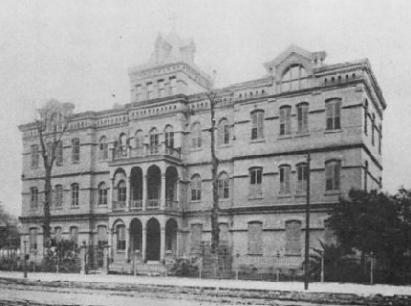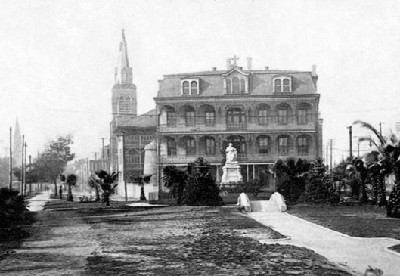| Shelter for the Children: Orphan Asylums of Old New Orleans |
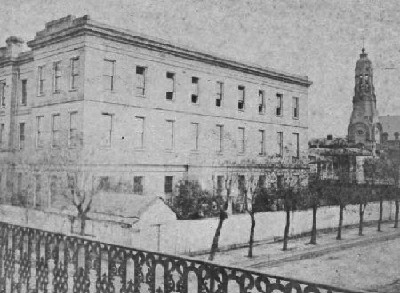
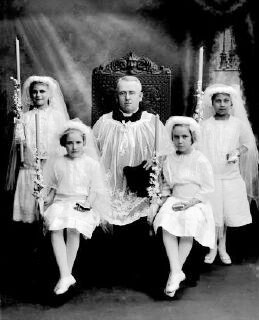
| Female Orphan Asylum, statue of Margaret Haughery in foreground, early 1900's |
"Camp Street Female Orphan Asylum, Camp and Prytania Streets (also known as N. O. Female
Orphan Asylum) - The Camp Street Asylum is one of the largest in the city and is managed by the
Sisters of Charity. It was founded in 1830 by Sister Regis and is designed as an asylum to educate
children transferred from St. Vincent's Infant Asylum. The asylum is ably conducted and its labors
are well appreciated. The late Margaret Haughery, the benevolent baker, was for many years one of
its best friends and foremost supporters." (Continued below.)
Orphan Asylum) - The Camp Street Asylum is one of the largest in the city and is managed by the
Sisters of Charity. It was founded in 1830 by Sister Regis and is designed as an asylum to educate
children transferred from St. Vincent's Infant Asylum. The asylum is ably conducted and its labors
are well appreciated. The late Margaret Haughery, the benevolent baker, was for many years one of
its best friends and foremost supporters." (Continued below.)

| Above, Female Orphan Asylum and Margaret Haughery statue, 1920; right, First Communion at the orphanage, date unknown. |
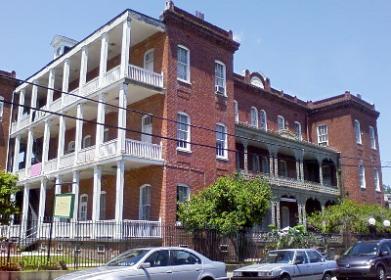
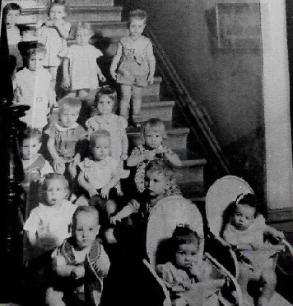
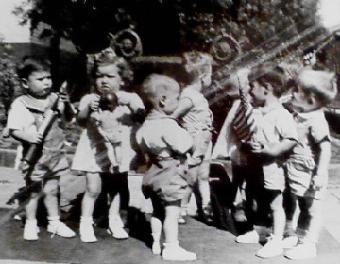
From "New Orleans Guide" by James S. Zacharie, published in 1885:
"Owing to the great epidemics that have visited New Orleans, often sweeping away parents and
leaving numerous children to the charity of the world, it became necessary to found asylums for the
many orphans, and there is perhaps no other city in the United States where there are more
establishments of the kind and where such institutions enlist as much popular sympathy. The names
of Poydras, Milne, Fink, Sister Regis and kind Margaret Haughery, the baker, are greatly revered for
their good works and timely aid in founding and sustaining these homes of mercy. The institutions
are supported by moneys derived from bequests, popular contributions, proceeds of charitable
entertainments and city and state aid, besides which, great pains are taken to make the institutions
as nearly self-supporting as possible, by taking in washing, sewing and doing other manual labor.
"Children who are left without mothers are often placed in the asylums by their fathers for education
and religious training. These "half orphans," as they are called, pay a small sum for their
maintenance. The asylums are open to inspection at any time and are well worthy of a visit. In some
of the asylums, a contribution box is placed near the door for those who desire to assist in this good
work to deposit money. The Catholic asylums are foremost in this noble work. Among the many
asylums, the following are well worthy of a visit.
"St. Vincent's Infant Asylum, Magazine and Race Streets - St. Vincent's is generally known as the
"Baby Asylum," and is the most interesting asylum to visit on account of the number and tender age
of its inmates, as well as to see how the patient Sisters of Charity can manage the care of so many
little ones. It serves as the Foundling Asylum of the city, and contains over two hundred children. As
the little inmates are entirely helpless, all strangers should not forget to drop some contribution in the
box, as it will assist the kind sisters in their good work." (Continued below.)
"Owing to the great epidemics that have visited New Orleans, often sweeping away parents and
leaving numerous children to the charity of the world, it became necessary to found asylums for the
many orphans, and there is perhaps no other city in the United States where there are more
establishments of the kind and where such institutions enlist as much popular sympathy. The names
of Poydras, Milne, Fink, Sister Regis and kind Margaret Haughery, the baker, are greatly revered for
their good works and timely aid in founding and sustaining these homes of mercy. The institutions
are supported by moneys derived from bequests, popular contributions, proceeds of charitable
entertainments and city and state aid, besides which, great pains are taken to make the institutions
as nearly self-supporting as possible, by taking in washing, sewing and doing other manual labor.
"Children who are left without mothers are often placed in the asylums by their fathers for education
and religious training. These "half orphans," as they are called, pay a small sum for their
maintenance. The asylums are open to inspection at any time and are well worthy of a visit. In some
of the asylums, a contribution box is placed near the door for those who desire to assist in this good
work to deposit money. The Catholic asylums are foremost in this noble work. Among the many
asylums, the following are well worthy of a visit.
"St. Vincent's Infant Asylum, Magazine and Race Streets - St. Vincent's is generally known as the
"Baby Asylum," and is the most interesting asylum to visit on account of the number and tender age
of its inmates, as well as to see how the patient Sisters of Charity can manage the care of so many
little ones. It serves as the Foundling Asylum of the city, and contains over two hundred children. As
the little inmates are entirely helpless, all strangers should not forget to drop some contribution in the
box, as it will assist the kind sisters in their good work." (Continued below.)
| Left & above, some of the children of St. Vincent's, date unknown, probably 1930's or '40's. These two photos and the current photo of St. Vincent's below were shared by Don Bourgeois. |
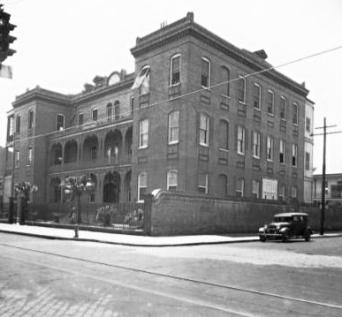
| Left, St. Vincent's, between 1920-1930; above, St. Vincent's, 2010. |
"St. Elizabeth's Asylum, Napoleon Avenue and Coliseum Street - This asylum faces Napoleon
Avenue and is a large three-story brick building with a mansard roof. The institution is under the
care of the Sisters of charity and is to a great extent self-supporting. After the female orphans at the
Camp Street Asylum have reached a certain age, they are transferred to this asylum and are taught
to sew and do fine needle work. As soon as they reach womanhood, situations are found for them
and, for a time, the good sisters look after their welfare."
Avenue and is a large three-story brick building with a mansard roof. The institution is under the
care of the Sisters of charity and is to a great extent self-supporting. After the female orphans at the
Camp Street Asylum have reached a certain age, they are transferred to this asylum and are taught
to sew and do fine needle work. As soon as they reach womanhood, situations are found for them
and, for a time, the good sisters look after their welfare."
| St. Elizabeth's, date unknown |
| "Jewish Orphan's Home, Jackson Avenue and Chippewa Streets - The Jewish Home is one of the best managed institutions in the city and is the pride of the Jewish citizens, under whose fostering care it is placed. The children are well taken care of and educated in their faith and are the object of much devotion on the part of the Jewish community, who, with their proverbial charity to each other, maintain almost wholly, without outside assistance, this noble asylum." (Continued below.) Right, the second Jewish Orphan's Home, ca. 1890's; below, the first home, 1885. |
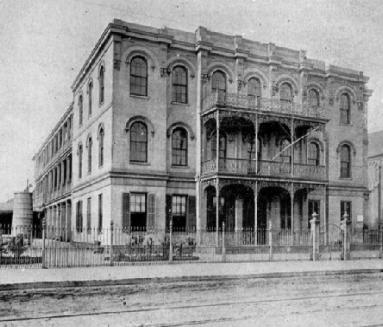
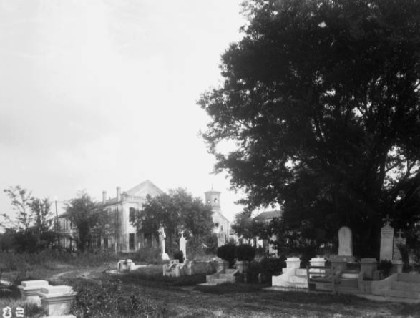
"House of Good Shepherd, Bienville Street (also known as Boys House of Refuge) - The House of
the Good Shepherd is one of the useful institutions of the city and is designed as a reformatory. The
buildings are very extensive and comprise working rooms, dormitories, chapel and other
departments. The institution, which is under the management of the Sisters of the Good Shepherd,
is divided into several distinct parts, one portion being for those who are placed there by their
parents and another for those committed by the city magistrates. All are employed in various
household duties, and do the washing and sewing of the hotels, steamboats and families.
the Good Shepherd is one of the useful institutions of the city and is designed as a reformatory. The
buildings are very extensive and comprise working rooms, dormitories, chapel and other
departments. The institution, which is under the management of the Sisters of the Good Shepherd,
is divided into several distinct parts, one portion being for those who are placed there by their
parents and another for those committed by the city magistrates. All are employed in various
household duties, and do the washing and sewing of the hotels, steamboats and families.
| In the background, House of Good Shepherd; cemetery in the foreground is described as Cypress Grove Cemetery, but I think it may be the Masonic Cemetery; date unknown. |
"Poydras Male Orphan Asylum, St. Charles Avenue and Dufossat Street / Poydras Female Asylum,
Magazine Street and Peter's Avenue - When Julien Poydras, a wealthy citizen of New Orleans, died,
he left all of his property for the benefit of the poor and with these means, two asylums have been
erected and are maintained in a worthy manner. These institutions are managed by a board of
directors and the children are well taken care of and educated with great care.
"Episcopal Home, Jackson Avenue and St. Thomas Street - This asylum for girls, under the direction
of the Sisterhood of the Protestant Episcopal Church, occupies a large brick building on Jackson
Avenue and is well managed institution. The girls, under the pious sisters, are educated and well
cared for.
"St. Mary's Orphan Boy's Asylum, Chartres and Mazant Streets - This institution occupies nearly a
square of ground and consists of a series of buildings, which the patient priests have gradually built
and added to as the years rolled by and the funds came in. The boys are taught useful trades and
attached to the institution is a farm situated below the city."
Magazine Street and Peter's Avenue - When Julien Poydras, a wealthy citizen of New Orleans, died,
he left all of his property for the benefit of the poor and with these means, two asylums have been
erected and are maintained in a worthy manner. These institutions are managed by a board of
directors and the children are well taken care of and educated with great care.
"Episcopal Home, Jackson Avenue and St. Thomas Street - This asylum for girls, under the direction
of the Sisterhood of the Protestant Episcopal Church, occupies a large brick building on Jackson
Avenue and is well managed institution. The girls, under the pious sisters, are educated and well
cared for.
"St. Mary's Orphan Boy's Asylum, Chartres and Mazant Streets - This institution occupies nearly a
square of ground and consists of a series of buildings, which the patient priests have gradually built
and added to as the years rolled by and the funds came in. The boys are taught useful trades and
attached to the institution is a farm situated below the city."
I've come across several more orphan asylums in New Orleans' long charitable history to add to Mr.
Zacharie's list and there have, undoubtedly, been many others through the years. Other orphanages
I've read about: Evangelical Lutheran Bethlehem Orphan Asylum, Fink Orphan Asylum - under the
auspices of Protestant Churches, Immaculate Conception Girls Asylum - operated by Sister
Marianites of the Holy Ghost, German Protestant Orphan Asylum, St. Joseph's Orphan Asylum -
under the auspices of the Sisters of Notre Dame, Lafon Orphan Boy's Home, Liners' Harvest Home,
Mount Carmel Asylum for Girls - managed by Sisters of Mount Carmel, Sacred Heart Orphan Asylum -
under the auspices of the Missionary Sisters of the Sacred Heart, Protestant Orphans Asylum,
Providence Asylum, St. Alphonsus Orphanage - operated by the Sisters of Mercy, St. John
Berchman's Asylum for Girls - operated by the Sisters of the Holy Family, Roberson Memorial Home,
Societe Francaise de Bienfaisance Asylum, an orphanage run by the Little Sisters of the Poor, St.
Mary's Catholic Orphan Boys Asylum - managed by Sister Marianites of Holy Cross, the Waldo Burton
Memorial Home.
Zacharie's list and there have, undoubtedly, been many others through the years. Other orphanages
I've read about: Evangelical Lutheran Bethlehem Orphan Asylum, Fink Orphan Asylum - under the
auspices of Protestant Churches, Immaculate Conception Girls Asylum - operated by Sister
Marianites of the Holy Ghost, German Protestant Orphan Asylum, St. Joseph's Orphan Asylum -
under the auspices of the Sisters of Notre Dame, Lafon Orphan Boy's Home, Liners' Harvest Home,
Mount Carmel Asylum for Girls - managed by Sisters of Mount Carmel, Sacred Heart Orphan Asylum -
under the auspices of the Missionary Sisters of the Sacred Heart, Protestant Orphans Asylum,
Providence Asylum, St. Alphonsus Orphanage - operated by the Sisters of Mercy, St. John
Berchman's Asylum for Girls - operated by the Sisters of the Holy Family, Roberson Memorial Home,
Societe Francaise de Bienfaisance Asylum, an orphanage run by the Little Sisters of the Poor, St.
Mary's Catholic Orphan Boys Asylum - managed by Sister Marianites of Holy Cross, the Waldo Burton
Memorial Home.
